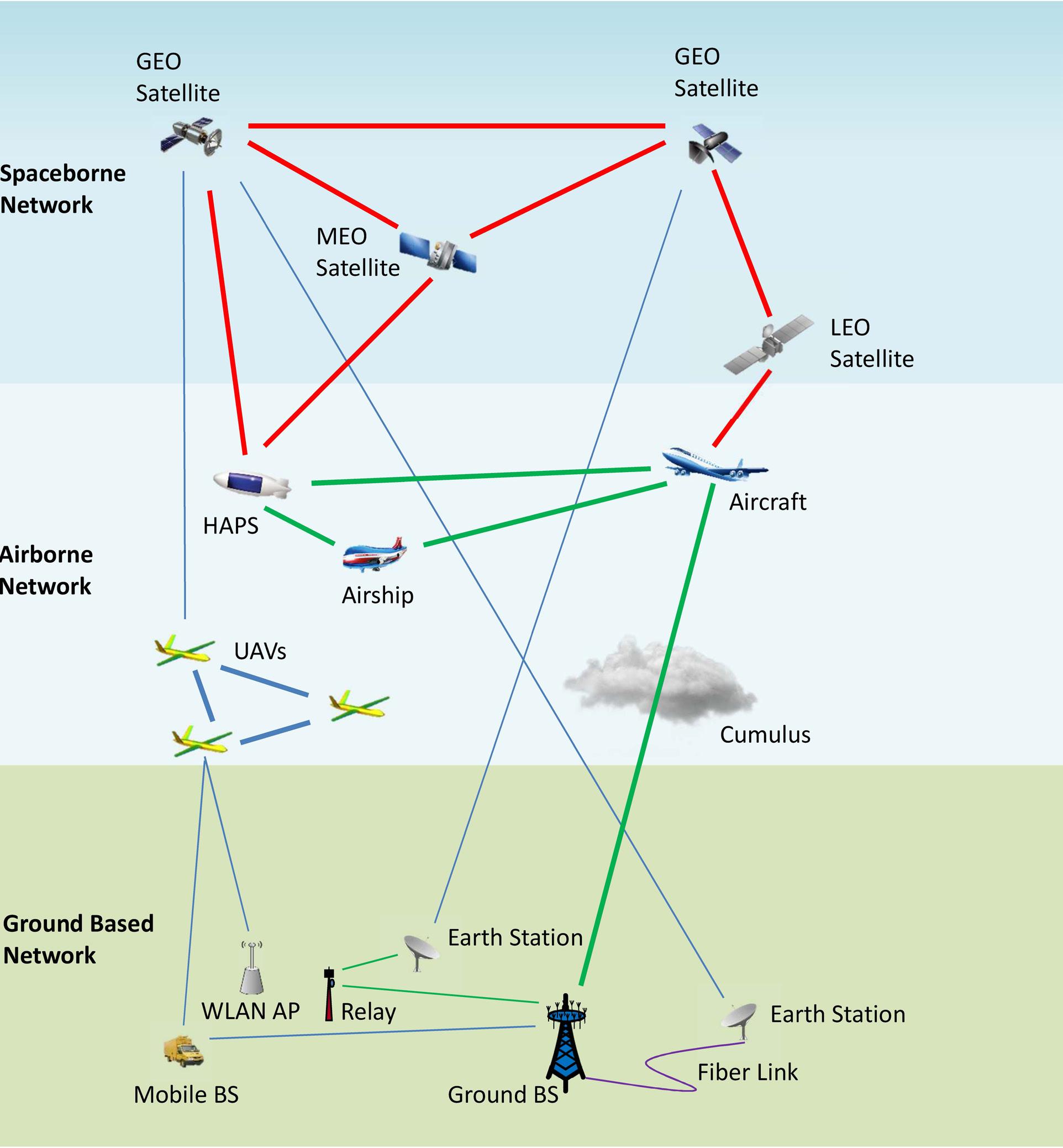Towards Ubiquitous Connectivity in Australia
Connectivity Innovation Network White Paper
Authored by

17th April 2024
Y. Jay Guo, Yonghui Li, and Ian Oppermann

Introduction
We are in an era of unprecedented technological growth, where data-driven AI is already reshaping our lives and workplaces. Augmented and virtual reality are poised to become parts of our daily lives. Industries are embracing digital twins, which mirror the real world to the virtual world, to increase productivity. All these transformative innovations rely on one crucial element: ubiquitous connectivity. Despite the rapid growth of the telecommunications industry in the last two decades, we are far from having ubiquitous connectivity in many parts of Australia.
The recently released NSW Digital Connectivity Index, developed by the NSW Telco Authority, 1 shows that there are very different levels of access and availability to affordable, reliable communications in remote and rural areas of NSW. The consequence is a digital divide that impacts well-being and social outcomes. In a digital society, connectivity is the main driver for inclusion and active participation. It supports strong economies, a modern and smart government, and resilient and safe communities. Poor connectivity also leaves these populations vulnerable during natural disasters. Hence, a fundamental enhancement in connectivity quality is imperative.
The paper first outlines the importance of connectivity in the context of Australia, and New South Wales in particular. The paper examines the characteristics of connectivity that are important for digital services and presents an overview of emerging technologies that have the great promise to provide fit-for-purpose ubiquitous connectivity to remote and rural areas. These emerging technologies include low earth orbit (LEO) satellites, high altitude platform stations (HAPS), Large-Area Wi-Fi, and 6G mobile communications. To conclude the white paper outlines potential pathways to improve connectivity in NSW and Australia.
Connectivity Matters
02 Meaningful connectivity lies at the heart of the NSW Telco Authority’s (NSWTA) strategy. 2 Meaningful connectivity includes the seamless connection and access of data and applications through a variety of devices; from mobile handsets to tablets, laptops, sensors, video terminals, and other accessible and usable connected devices. Meaningful connectivity aims to support citizens to access work, study, or business opportunities, stay in touch with loved ones, and enhance safety and security during natural disasters.
For the purposes of this paper, ubiquitous connectivity is defined as the state where every individual, community, and industry has reliable and continuous access to high-quality digital services, regardless of geographic location or population density.
The NSW Government Connectivity Strategy 3 has the following objectives:
• Broaden access to world-class digital connectivity,
• Address digital connectivity and services affordability,
• Ensure there is sufficient readiness for digitisation.
Given the potentially varied interpretations of ubiquitous connectivity, our definition serves as a guiding principle for the remainder of the paper. Continuous clarification throughout the white paper will reference and build upon this definition, ensuring a shared understanding as the paper explores the challenges and solutions related to connectivity in NSW.
The well-known “tyranny of distance” has historically remained challenging for community development, access to markets, and growth of local industry. The advent of COVID-19 restrictions showed just how quickly digital technologies can be embraced by many industries and job types. It also showed just how dependent communities have become on network connectivity. Those regions with limited connectivity were least able to adapt to living and working online. There are still industries and job types that are least able to move online, but they are expected to become more reliant on connectivity due to the needs of increased productivity, marketing, and customer engagement. The blend of online and real-world interactions and value creation is likely to move towards increasing use of online and digital services in all parts of Australia. 4 Widespread access to reliable connectivity therefore becomes an even greater longterm imperative for all communities.
“The state where every individual, community, and industry have reliable and continuous access to high-quality digital services, regardless of geographic location or population density.”
Although Australia has a long history of fire and flood cycles, recent years have seen the growing scale of impact on communities. Towns in Queensland and New South Wales that needed to truck water in to keep communities going in 2021 5 were the same communities struggling to cope with a series of flood events in 2022. Future developments, which ignore the impact of a changing climate – whether it be water availability or the growing intensity and frequency of natural disasters – do so at their peril. The ability to understand the impact of
natural disasters on communities and infrastructure, and to deliver effective responses to disaster events require increased connectivity in many forms, from environmental sensing to mobile and satellite communications as well as Public Safety Mobile Broadband (PSMB).
Our response to COVID-19 clearly demonstrated the value of connectivity driving the rapid response to the pandemic. Understanding how travel and lockdown restrictions affected crucial services and infrastructure — such as maintaining safety in nursing homes and keeping power stations operational — demanded almost instantaneous connectivity. Access to mobile communications 6 is essential to e-commerce — particularly card transactions — in remote communities.
Amidst these challenges and in the context of our aging population, there’s an enduring expectation of an ever-improving quality of life. Making our services ‘smarter’ demands that we understand what is happening in communities, identify the root causes of problems, and can predict when things will go wrong so all stakeholders can plan ahead. Much of that ability to become “smarter” relies on connectivity.
Connectivity underpins the health and growth of our digital economy and the well-being of our citizens. Improved connectivity in NSW is critical to the Government and the people of NSW. The main benefits of ubiquitous connectivity include:
• Delivery of government digital services to citizens: helping state, Federal, and Local Government fill gaps in connectivity is critical to delivering public services, such as education and healthcare.
• Improved community resilience : ubiquitous connectivity will enable Emergency Services Organisations and other community groups to stay in touch and cooperate in real-time to increase community resilience during emergencies and natural disasters.
• Greater digital inclusion : ubiquitous connectivity will improve the accessibility, affordability, and readiness of remote communities to digital services.
• Improve business and industry competitiveness, growth, and innovation : with ubiquitous connectivity, businesses in NSW, big and small, can grasp market trends, collaborate effectively, manage suppliers and logistics, and enhance customer service as industry ecosystems go digital.
Characterising Connectivity
03 Connectivity has many facets. Different service types require different characteristics of connectivity. These characteristics primarily include:
• Coverage or access : the most important characteristics of connectivity. Without coverage, there is no connectivity.
• Data rates : a fundamental characteristic of communications systems and may range from 10’s of bits per second for sensor networks, through to hundreds of millions of bits per second to support high-definition video systems or aggregate company requirements.
• Latency : relevant to mission-critical services and operations as well as interactive services such as video conferencing.
• Dropout rates : important for interactive, real-time, or delay critical systems.
Additional consideration also needs to be given to the ability to access services “on the move”. Technologies supporting it are mainly mobile communications networks including 3G/4G/5G and the upcoming 6G. Activities that can be conducted at a “stationary” location or within a short proximity of this location, will not be limited to such requirements and only need to meet the threshold requirements. Examples of “on the move” and “stationary” activities are detailed in Figure 1. IoT activities may also be either “on the move”, “stationary” or both. However, IoT is not a connectivity technology, though it needs connectivity for the objects to be connected.
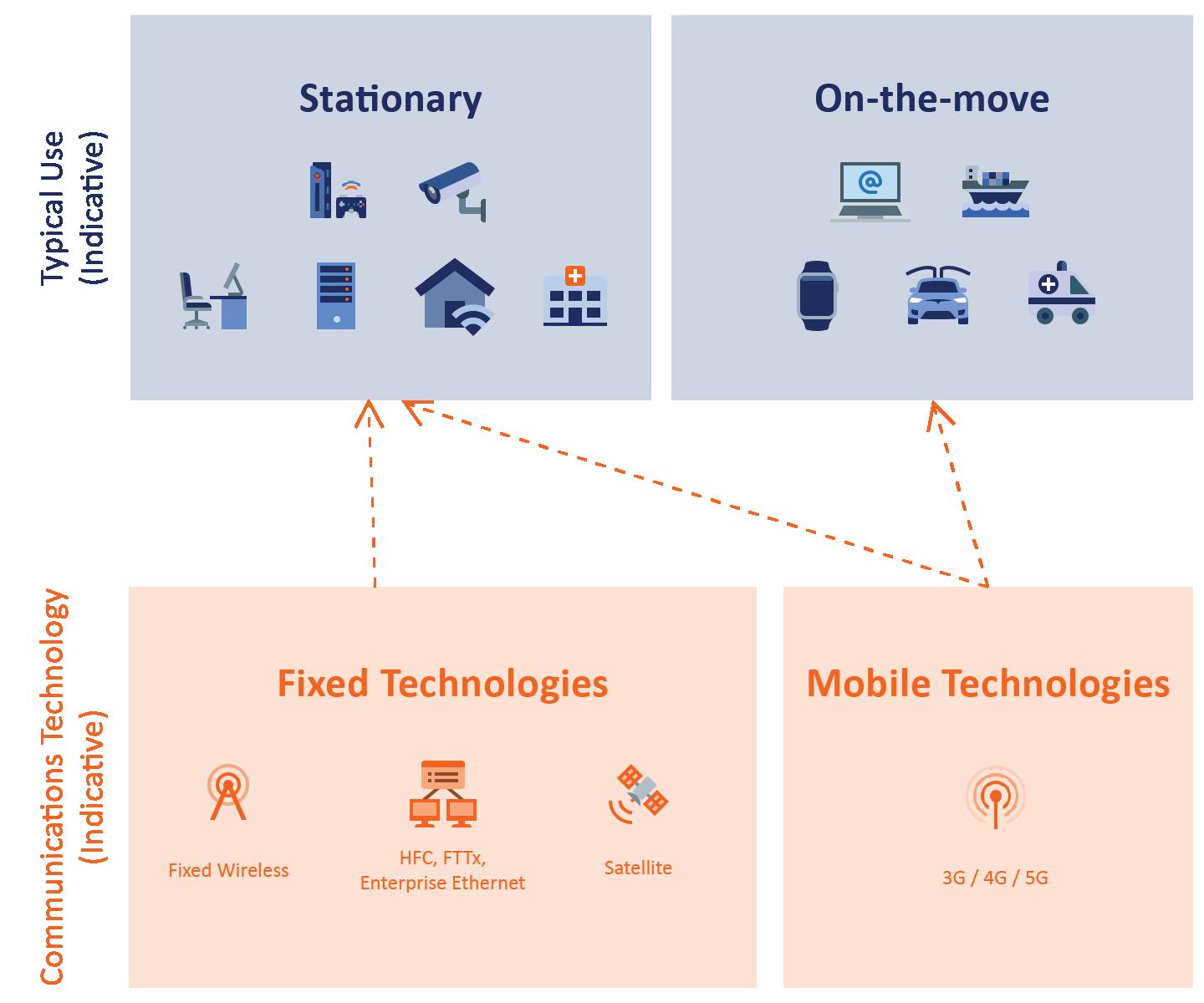
Connectivity services delivered by satellite have the potential to cover the entire state of NSW. The NBN’s geostationary (GEOs) satellites do cover all of NSW but have moderate data rates (maximum burst speeds of 100/5 Mbps downlink and uplink respectively but more typically 25/5 Mbps) and suffer from outages which reduce the effective use of some real-time or interactive services. 7
3.1 The State of Connectivity in Australia and New South Wales
The existing telecommunications infrastructure in Australia and New South Wales has witnessed substantial growth and transformation over the years. vv
In major urban centres, there are well-developed high-speed optical fibre networks, supporting digital connectivity for
businesses, residents, and public services. In metropolitan areas, high population density ensures that wired and wireless broadband services are widely accessible. These regions enjoy relatively high data rates and low latency, which are essential for activities ranging from remote work and online education to entertainment and e-commerce. Government agencies and businesses in these areas have been able to leverage advanced digital tools and services to enhance their operations and improve the quality of life for their residents.
Remote and rural regions, however, often suffer from limited coverage. The vast geography of New South Wales, which includes many remote communities, presents significant challenges in extending telecommunications infrastructure. Sparse population density and difficult terrain can make it economically unviable for service providers to invest in expanding coverage.

While multiple “Mobile Blackspot” programs have been undertaken, publicly available coverage maps of the major mobile operators in NSW still show significant areas with no coverage as shown in the example of current Telstra coverage of 3G/4G/5G in Figure 2. The Telstra 3G network is expected to close in mid-2024.
A different and arguably richer perspective is offered by the NSW Digital
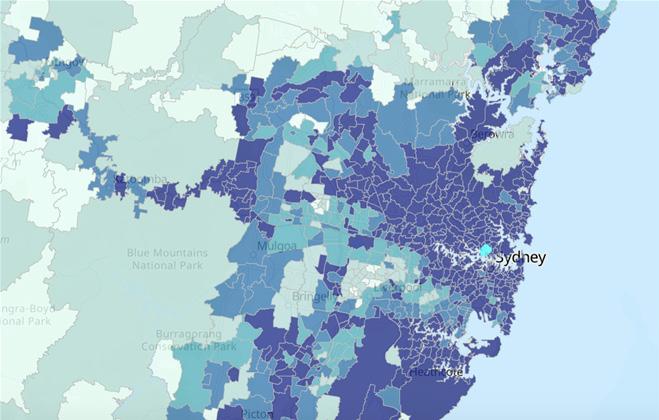
Connectivity Index (see Figure 3). This index is a measure of the quality and effectiveness of digital connectivity in NSW. It indicates the capability of a location to support various digital activities, such as remote work, online learning, or mobile internet usage. It again shows regions of poor coverage, but also regions where access to connectivity is limited in choice or is less widely taken up.
3.2 The Consequences of Connectivity Gaps in Regions
In a digital society, connectivity is the main driver for inclusion and active participation. It supports strong economies, a modern and smart government, and resilient and safe communities. Poor connectivity also leaves these populations vulnerable during natural disasters. Hence, a fundamental enhancement in connectivity quality is imperative. The consequences of connectivity gaps include:
• Inequity in access to services : Some communities, particularly in less populated regions, lack the same level of access to essential digital services, creating disparities in education, healthcare, and economic opportunities.
• Affordability: Some areas have a prohibitively high cost of connectivity, making it difficult for residents and businesses to access and afford high-quality digital services.
• Latency: While latency may be low in urban centres, some rural areas may experience higher latency, affecting the quality of services, particularly for mission-critical applications, telemedicine, and video conferencing.
• Infrastructure Resilience: Remote and regional areas are often more susceptible to natural disasters. Ensuring that telecommunications infrastructure remains resilient and operational during emergencies is a critical challenge.
3.3 Connectivity Addresses the Digital Divide
Addressing these challenges and gaps in connectivity is vital for ensuring that all regions in Australia, including New South Wales, can fully leverage the benefits of digital technology and participate in the digital economy. The need for strategic planning, investment, and collaboration between government, industry, university and communities is paramount to bridge these gaps and achieve ubiquitous connectivity.
Ubiquitous connectivity serves as a potent force in addressing the digital divide, offering a transformative potential to bridge gaps and promote inclusivity.
By strategically investing in connectivity infrastructure development, governments and organisations can lay the foundation for widespread access, reaching populations that have traditionally been excluded from the digital landscape.
Community engagement emerges as a pivotal element in fostering inclusivity. Collaborative efforts involving local communities, public and private sectors, and non-profit organisations can tailor connectivity solutions to the specific needs of diverse populations. This approach ensures that initiatives are culturally sensitive, contextually relevant, and aligned with the socio-economic realities of different regions.
Inclusivity in connectivity also entails addressing affordability barriers. Implementing cost-effective solutions, subsidy programs, or innovative business models can make connectivity more accessible to marginalised communities.
By considering the financial constraints of underserved populations, these strategies
can democratise access and promote digital equity.
Education plays a central role in fostering inclusivity through connectivity. Leveraging digital platforms for remote education, digital literacy programs, and skill development initiatives can empower individuals in underserved areas. This not only provides access to information but also equips people with the tools and
“Ubiquitous connectivity serves as a potent force in addressing the digital divide , offering a transformative potential to bridge gaps and promote inclusivity.”
knowledge to actively participate in the digital age, breaking down barriers to socio-economic advancement.
By focusing on these strategies, ubiquitous connectivity becomes a catalyst for inclusivity, creating pathways for marginalised communities to actively engage in the digital ecosystem. These efforts not only bridge the existing gaps in digital access but also contribute to a more equitable and inclusive society.
Emerging Connectivity Solutions
04 In the global push to advance 5G and eventually to introduce 6G, numerous global initiatives are underway to expand the coverage of wireless and satellite communications to the oceans and the air, as well as to remote and hard-to-reach areas on the land. Such initiatives include the industry development of LEO satellite systems, and high-altitude platform stations (HAPS) that fly in the stratosphere about 20 km above the Earth and beyond 6G. The provision of airborne and spaceborne networks, collectively called non-terrestrial networks (NTN), is expected to support worldwide mobile communications with ultra-wide coverage and improved disaster resistance as well as enhanced 5G.
Owing to Australia’s large land mass and relatively small population, providing ubiquitous national connectivity has proven to be a daunting task. Both the Australian Federal Government and NSW State Government have been making steady investments to improve the connectivity for citizens and communities, but Australia still has a long way to go to achieve ubiquitous connectivity. In our view, potential solutions to ubiquitous connectivity necessarily consist of a myriad of different networking technologies and the public and private partnership for investment. The following section presents an overview of a number of such technologies.
4.1 Low Earth Orbit Satellites Communications
Satellite communications are undoubtedly a desirable technology for providing coverage to a geographically large nation like Australia. The NBN Co, a commercial enterprise of the Australian Federal Government, was created a decade ago to deliver broadband services across Australia. NBN Co’s GEO satellites, NBN Sky Musters, have enabled all remote communities to have access to fixed broadband. This system supports 101 spot beams from the satellites to cover all of Australia including remote islands. As shown in Figure 4, the blue spot beams have a radius of 325km for more sparsely populated areas and the red spot beams have a radius of 125km for more densely populated areas. Although NBN Co’s satellites represented state-of-the-art technology at the time they were designed, the rapidly-growing needs of data-intensive services and competition from other solutions are posing serious challenges to NBN Co’s future satellite business.
The fundamental problems of GEO satellites lie in their inherent disadvantages, including high latency and high terminal cost due to their high altitude (about 36,000km) above the Earth, and the high cost of each satellite to launch, maintain and upgrade. The NBN
Co is limited in its capacity to address these challenges. Therefore, GEO satellites are only part of the solution to ubiquitous connectivity. Since GEO satellites require ground terminals to have a large, highgain antenna (dish), it is not suitable for individual mobile users. In the last two decades, great efforts have been made to develop beam-steerable antennas to mount on moving vehicles for GEO satellite communications. This is generally called Satellite on the Move and has been used for services including defence and consumer entertainment. Given the inherent disadvantages of GEO satellites, however, GEO satellite operators like NBN Co. are likely to gradually shift their focus to specialist government and enterprise services as opposed to supporting the general public and industry. Specifically, it is expected that NBN Co will decommission its GEO satellite services in the early 2030s.
Thanks to the push of several hightech companies such as OneWeb and StarLink, LEO satellites are emerging as a much more attractive technology to provide coverage for remote and rural communities. A fundamental advantage of LEO satellites is that they are much closer to the Earth (about 12,000km or lower), so much smaller dishes can be used for both the satellites and users. The lower altitude also means a lower signal
propagation latency. A further advantage of LEO satellites is that they are relatively cheap to build and launch, so upgrades and replacements become easier. Each LEO satellite constellation consists of dozens to thousands of satellites. This means that the connectivity provided is much more resilient, as losing an individual satellite would not have a major impact on the overall system performance.
Integration of LEO with terrestrial networks: to ensure a positive user experience, and address regulatory considerations, seamless integration with terrestrial networks is paramount for optimising performance. Ground stations act as a crucial backbone for satellite systems, significantly contributing to the reduction of latency and the enhancement of overall connectivity. This is particularly important for applications requiring real-time interactions, where delays can adversely impact user satisfaction. The presence of ground stations within the country enables better control over data sovereignty. By aligning with local regulations and data protection laws, satellite providers can ensure that data is processed and stored in compliance with the legal frameworks of the region. This not only enhances regulatory adherence but also fosters trust among users regarding the handling of their data. To mitigate potential disruptions and
uphold service reliability, satellite internet providers incorporate redundancies. These redundancies serve as backup systems and alternative pathways, effectively managing issues such as signal loss or interruptions. The strategic implementation of redundancies is a crucial aspect of satellite network design, contributing to the robustness of the overall connectivity infrastructure.
Applications of LEO satellites: one of the paramount applications of LEO satellites lies in their ability to bridge the connectivity gap, especially in remote and underserved areas. Unlike traditional geostationary satellites, LEO satellites offer low-latency communication services to regions where terrestrial infrastructure is sparse. This includes remote villages, islands, and areas with challenging topography. The practical impact of this application is profound, as it extends internet access, enabling educational, economic, and healthcare opportunities in previously isolated communities.
LEO satellites emerge as indispensable assets in emergency scenarios and disaster response efforts. Their low latency and global coverage enable swift and reliable communication during crises. Whether responding to natural disasters, such as earthquakes or hurricanes, or managing unforeseen emergencies, LEO satellites
provide essential connectivity for first responders, aid organisations, and affected populations. Real-time information transmission becomes a lifeline, facilitating coordinated efforts and enhancing overall disaster resilience.
Beyond connectivity, LEO satellites contribute significantly to environmental monitoring through Earth observation. The relatively short distance of LEO satellites above the Earth also means that they can be used for high spatial-resolution sensing. Applications include agriculture, bushfire and flood monitoring, and situation awareness in general. LEO satellites can monitor deforestation, assess crop health, and track changes in ecosystems. The data generated supports informed decision-making for sustainable resource management and proactive responses to environmental challenges. One issue many enterprise users are currently facing is that they can’t get real-time sensing information at the time they need it, especially if the situation they are dealing with is not well planned ahead of time, and a service is agreed upon with an LEO satellite operator accordingly.
The commercial realm benefits extensively from LEO satellite applications. From satellite-based internet services, as demonstrated by companies like SpaceX’s Starlink and OneWeb, to emerging
technologies like space-based advertising and data analytics, LEO satellites open new frontiers for innovative business ventures.
Limitation of LEO satellites: although it is possible to have LEO satellite phones for emergency text and voice services, it is very difficult for LEO satellites to support mobile broadband. Long-distance communications require high transmission power and high antenna gains achieved by large antennas. These conditions are hard to meet for mobile users. Theoretically, one can mount an extremely large smart antenna on the LEO satellites, but this will significantly compromise their cost advantages. To support mobile users, one solution is to use large satellite terminals that are fixed or mounted on a vehicle as an access point. Then, broadband services can be provided to individual users using access technologies such as Wi-Fi. Such a hybrid solution can and has been deployed to support special events, including NSWTA’s Vehicle as a Node (VaaN) program and the CIN-funded Large Area Wi-Fi project explored later in this paper.
While LEO satellites demonstrate exceptional performance in providing connectivity to densely populated and moderately remote areas, their effectiveness wanes in isolated terrains characterised by negligible population density. The considerable infrastructure
demands of LEO satellites involving the establishment of ground stations and associated costs pose economic impracticality in regions with limited connectivity demand. A prime example is remote islands with minimal economic activity, where the substantial upfront and operational expenses for ground stations may not be justified, constraining the viability of LEO satellite-based connectivity.
In scenarios involving remote roads within isolated terrains, LEO satellites may encounter interruptions due to their reliance on a network of ground stations for seamless coverage. Imagine a situation where a vehicle traverses a desolate stretch far from urban hubs, and the scarcity of ground stations leads to intermittent connectivity. This situation underscores the limitations of LEO satellites, particularly when the infrastructure demands for connectivity, such as ground stations, prove economically unviable in such remote contexts.
The infrastructure demands of LEO satellite connectivity, especially the need for ground stations, may not align with economic feasibility in specific cases. High Altitude Platform Stations (HAPS) emerge as a strategic solution in addressing these challenges, as the paper will discuss in Section 4.3. Positioned in
the stratosphere, HAPS serves as floating base stations that can seamlessly transition connectivity. In scenarios like remote roads, where terrestrial networks are absent, HAPS plays a pivotal role, ensuring continuous communication for moving vehicles without the economic constraints associated with the extensive ground infrastructure required by LEO satellites. HAPS thus offers a practical alternative, overcoming the limitations faced by LEO satellites in economically challenging and remote environments.
4.2 Large Area Wi-Fi
In many situations such as an emergency, special operations and postdisaster recovery, Wi-Fi systems potentially offer the ability to provide access to emergency communications over a large area where there is no fibre or terrestrial mobile network coverage. A satellite backhaul is needed then to connect the WiFi to the Internet. The existing commercial Wi-Fi access points (APs) are typically designed to cover a relatively small area like a home or an office. This means that providing coverage over a large area may need a large number of APs, but this would be prohibitively expensive or impractical for real world operations. Therefore, the CIN is working on innovations in the significant reduction of APs compared with conventional approaches to make large area coverage practical and affordable.
In principle, long range communications can be achieved by using directional antennas at the access points subject to regulations on maximum effective isotropic radiation power (EIRP). However, current Wi-Fi systems use carrier-sense multiple access (CSMA) protocols, where each device senses the channel before its transmission. This protocol cannot be used when user devices are far apart from each other as they would not be able to sense each other’s transmission. This is called a hidden node problem and would lead to frequent signal collisions and transmission failures.
The second challenge in large-area Wi-Fi coverage is to design an antenna with high gain and a wide angular range. Current WiFi systems use omnidirectional antennas, e.g., monopoles. They normally have low gain, usually less than 5 dBi. This low gain limits their ability to reach long distances. Directional antennas focus their signal in a specific direction, providing a narrow beamwidth and a high antenna gain. This increased gain allows for longer-distance communication, but these antennas have narrow beams in both the horizontal and vertical planes. This kind of antenna has been often employed in long-range point-to-point communications. However, they cannot be employed for applications that require a broader coverage area. Furthermore, many high-gain directional
antennas support only a single polarisation (usually either vertical or horizontal). This simplifies the antenna design and is often sufficient for point-to-point links or specific applications. However, in environments with multipath propagation or interference, polarisation diversity (using both vertical and horizontal polarisations) can help improve signal reliability by mitigating the effects of polarisation mismatch.
nodes as intermediate hops to forward the packets to far nodes to achieve a large coverage. The mesh solution requires a large number of Wi-Fi routers and thus is very costly and impractical for providing temporary coverage.
Limitations of Wi-Fi Mesh include the following:
• Potential Interference :
There are many products on the market aiming to extend the range of conventional Wi-Fi. These are listed in Table 1. The details of some of the systems are provided above.
Wi-Fi Mesh
To achieve large area coverage, one can ‘mesh’ many APs to form a network of Wi-Fi networks. The mesh protocol uses the close
Simultaneous communication among numerous nodes can result in interference, ultimately reducing performance. Effective channel planning and coordination are essential to address and mitigate this issue.
• Higher Latency: Wi-Fi mesh networks may exhibit higher latency compared to traditional single AP
setups. This is because data must pass through multiple nodes before reaching the destination, potentially causing slight delays.
• High Cost of Deployment: WiFi mesh networks require a large number of Wi-Fi routers in a large area deployment.
• Complex Configuration: Setting up a Wi-Fi mesh network generally requires a more complex configuration process compared to a single AP setup. It involves determining suitable node placement, optimising signal strength, and ensuring seamless handoff between nodes.
Wi-Fi HaLow
The Wi-Fi HaLow system operates in the 900MHz frequency range, which allows for longer-range communication with lower power consumption. In principle, the lower the frequency, the easier for wireless signals to travel further.
Unfortunately, Wi-Fi HaLow system has the following limitations:
• Lower Data Rates: The use of lower frequencies in the Wi-Fi HaLow system limits the achievable data rates compared to higher-frequency Wi-Fi standards. This makes it less suitable for applications requiring broadband connections.
• Not compatible with existing WiFi: Wi-Fi HaLow operates in the 900MHz frequency range and is not compatible with current Wi-Fi devices.
LoRa
LoRa system is uniquely designed to have long range communications at low power. However, the data rate is low as it is primarily intended to support Internet of Things (IoT) and other similar applications but is not suitable for broadband access.
Large-Area Wi-Fi System
Acknowledging the constraints of various existing Wi-Fi related systems on the market such as the above, the CIN funded a Large-Area Wi-Fi project in 2022. The primary objective of which is to tackle the two fundamental technical challenges in realising cost-effective large area coverage:
1. Developing a new Wi-Fi protocol stack to resolve hidden nodes issues while ensuring compatibility with existing Wi-Fi devices
2. Designing high-gain wide-beam antennas with dual polarisations
To tackle the hidden node problems, the project team developed a centralised WiFi protocol stack using readily available commercial Wi-Fi chipsets. In this setup, an AP manages resources allocation to various devices, efficiently preventing collisions and hidden node problems. The team developed a unique algorithm to dynamically allocate resources and data rates to various devices in an optimal and centralised way. This algorithm adapts to the dynamic requirements of different devices using minimal resources, extending transmission range and greatly reducing latency.
Unlike existing CSMA/CA protocols reliant on contention-based random access, the CIN Large-Area Wi-Fi project team’s approach ensures predictably low latency.
Through centralised management, the new protocol can achieve low and deterministic latency, essential for mission-critical applications and emergency services. Moreover, the team has developed a novel mechanism to seamlessly integrate this system with existing Wi-Fi devices, ensuring compatibility and a smooth transition.
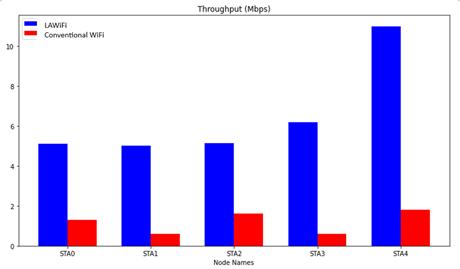

To provide wide area coverage, a wide beam, high-gain, and dual polarisation antenna with horizontal beamwidth of about 55° and antenna gain of 15 dBi has been developed. The beamwidths of existing commercial antennas that have more than 15 dBi gain are less than 30°. The shape of these beams are pencil beams to concentrate the transmitted or received signal energy into a narrow and focused direction. The project team has developed a new phase and amplitude modulation of the antenna elements to achieve a dual polarisations flat beam over a wide
angular range, which is shown in Figure 5. In addition, a compact and new feeding network has been designed to implement the developed modulations. Furthermore, a sub-array method has been introduced to enable a flexible gain increase without re-developing the modulations of each sub-
Figure 6 and Figure 7 compare the throughput and packet loss ratio of uplink transmission of large-area Wi-Fi and conventional Wi-Fi systems under the same transmission power in longrange transmissions, where 5 terminals are located at 1.5 km from the access point. As these figures show, the LAWi-Fi systems can achieve significantly higher data rate and lower packet loss ratio than the conventional Wi-Fi systems. The performance degradation of conventional Wi-Fi is due to its inability to handle the hidden node problems for long-range communications.
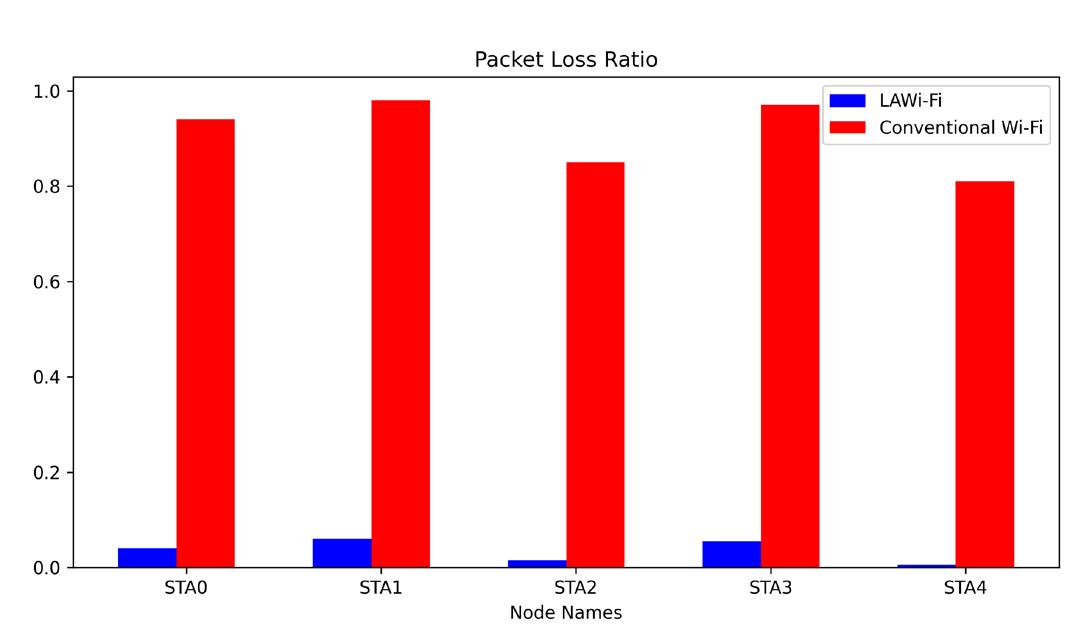
4.3 High Altitude Platform Station (HAPS)
High antenna towers are needed to provide Large-Area Wi-Fi coverage. Owing to the curvature of the Earth, the higher the communications antenna, the larger the area it provides line of sight (LoS) coverage. In the meantime, long distance communications also need high transmission powers and large antennas. This may not necessarily be an issue for base stations, but it is a critical one for mobile handsets or user terminals for satellite communications. To ease the requirements on mobile handsets, therefore, one solution is to lower the satellite platform altitude from Exosphere for LEO satellites at 12,00km to Stratosphere at around 20km (see Figure 8). This results in a technology called high altitude platform stations (HAPS). HAPs are effectively floating base stations.
There are two types of HAPS. The first type is Lighter-than-Air (LTA) HAPs, or balloons, which uses buoyancy to sustain flight. The second type is Heavier-thanAir platforms (HTA), such as fixed-wing aircrafts, which use aerodynamic lift forces
to remain airborne. LTA HAPs are cheaper and have been around for much longer. For instance, Thunderhead Balloon System® has been flown over wildfires in the Western United States. The disadvantage of this platform is that it is hard to control their positions and trajectories, so guaranteeing a specified coverage area is a challenge. In contrast, HTA HAPs are much more expensive, but they can keep their coverage fixed. As a result, most recent research and development (R&D) has been focused on the HTA HAPs platform. Undoubtedly, one can also develop hybrid platforms that sit in between the two types.
In comparison with satellite systems, HAPS are a relatively easy solution for air, sea and remote area connectivity, and an effective platform for emergency communications. Importantly, it can serve as an “ordinary” base station to connect mobile user terminals. HAPS can be connected to the nearest terrestrial network gateways and extend the reach of existing mobile services directly to enduser devices. The relatively short distance of HAPS makes the communications latency comparable to that of cellular systems.
The operating principle of HAPS communications are shown in Figure 9. The system consists of a HAPS platform, a base station mounted to the platform, and a ground station that connects the “floating” base station to a terrestrial network. One main challenge for HAPS technology is that, whilst it is difficult to keep the HAPS platform static, the intended coverage on the ground must remain stable.
In recent years, there have been a few international initiatives to develop and promote HAPS technologies. In 2017, for example, SoftBank established HAPSMobile Inc. HAPSMobile is currently conducting the development and commercialisation of Sunglider, a large fixed-wing HAPS. In 2022, Airbus, Nippon Telegraph and Telephone Corporation (NTT), NTT DOCOMO, and SKY Perfect JSAT Corporation begun their joint study on the feasibility of collaborating on future HAPs-based connectivity services as part of a future space-based wireless connectivity ecosystem. Their study aims to identify the early deployment requirements of a HAPS-based network. The collaboration is investigating the use of the Airbus
and the wireless communication networks of NTT, DOCOMO and SKY Perfect JSAT in order to test HAPS connectivity, identify practical applications, develop required technologies and ultimately launch spacebased wireless broadband services. Specific themes include the applicability of HAPS for mobile connectivity on the ground and base station backhaul, the performance of various frequency bands in HAPS systems, the technological considerations for linking HAPS with satellites and ground base stations. It is also reported that SoftBank Corp.’s HAPSMobile and Lendlease established joint venture to explore HAPS deployment in 2022 Australia.
Finally, the HAPS Alliance has been established to include Airbus, HAPS Mobile, Intelsat, Nokia, Ericsson and Air Services Australia. Most recently, the Northern Territory joined the HAPS alliance, positioning themselves as the home of HAPS in the Indo-Pacific region.
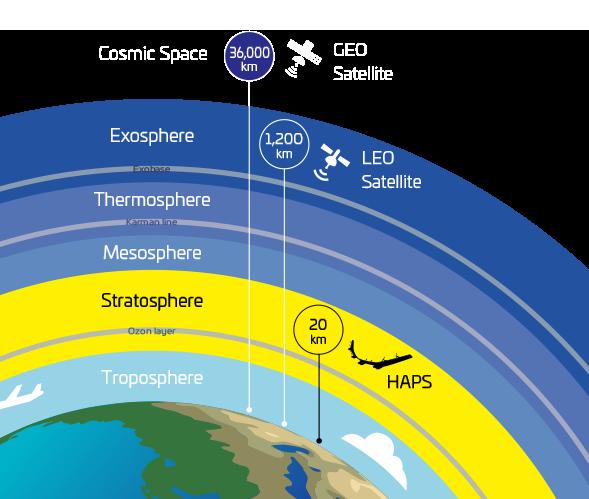
4.4 The Coming 6G
Although the majority of the world is still in the early stages of 5G deployment, the telecommunications industry and research community have already made significant progress in defining the standards of 6G, also known as IMT-2030. The standards will include both 6G use cases and technical specifications. An illustration of usage scenarios of 6G is shown in Figure 10. In comparison to 5G, 6G aims to achieve three new usages as well as extensions to 5G usages. The three new usages include ubiquitous connectivity, integrated sensing and communications (ISAC), and integrated AI and communications. Whilst the integration of AI and communication is happening to some extent in 5G already, the ubiquitous connectivity and the integrated sensing and communication (ISAC) are new usages. The latter is also known as a ‘network as a sensor’. Though the notion of “anytime anywhere” connectivity has been around since 3G, it is exciting to see ubiquitous connectivity now is formally part of the 6G usages.

Previous generations of mobile communications networks including 5G have focused on terrestrial networks. 6G aims to provide ubiquitous coverage across the globe. The basic physics dictates that the terrestrial networks alone will not result in ubiquitous coverage. To achieve ubiquitous global coverage, therefore, 6G is poised to integrate terrestrial networks with non-terrestrial networks (NTN). A possible architecture of such a system is given in Figure 11. Satellites and airborne platforms will play important roles when it comes to ubiquitous connectivity.
5G mobile and wireless systems are primarily ground based, with coverage requirements similar to earlier generations of terrestrial networks. In contrast, airborne and spaceborne communication networks, also known as NTNs, offer the potential ubiquitous coverage for widespread coverage, spanning people and vehicles over sea, air, remote, and rural areas, complementing terrestrial networks. To propel advancements beyond the capabilities of 5G, future communications networks must seamlessly integrate NTNs with terrestrial networks. This integrated wireless ecosystem may become one of the most ambitious targets of 6G systems. The envisioned goal for 6G wireless systems is to support truly global wireless communications for the first time, accessible anywhere and at any time. Consequently, the development of technologies to achieve a high-capacity NTNs at a reduced cost holds significant importance in the journey towards 6G.
It is anticipated that any eventual 6G and beyond mobile wireless communications networks would thus consist of three network layers: the space network layer, the airborne network layer and the terrestrial network layer. Figure 11 clearly suggests that there will be a huge number of dynamic nodes constituting the mobile airborne networks, in addition to the dynamic nodes of the ground and satellite networks.
Airborne networks have a number of unique characteristics. First, most of their nodes would have multiple links to achieve network reliability, high capacity and low latency. Second, most of them will be mobile — therefore, both their network links and topologies will vary with time, some faster than others. Third, the distances between any two adjacent nodes will vary significantly, from hundreds of meters to tens of kilometres. Fourth, the power supplied to

any node would be limited. Consequently, as in the case of terrestrial networks, the energy efficiency of each node not only impacts the operation costs but also the commercial viability of the entire network.
6G poses several significant and interesting challenges for future antenna technologies. The antennas, for example, must be compact and high gain. They must be reliable, lightweight, and low cost. The antenna arrays






must provide individually steerable multiple beams; dynamic reconfiguration of their patterns, polarisations, and frequencies to cope with the movement of the platforms, and overall high energy efficiency. The biggest challenge amongst all of them is arguably the reduction of the overall energy consumption.
In addition to significantly improved connectivity, another important feature of 6G is integrated communications and












sensing, which is illustrated in Figure 12. The essence of ISAC is to add sensing capability to the traditionally communications-only network. When a wireless signal travels from a transmitter to a receiver, the received signal is impacted by the surrounding environment. The change in the characteristics of the received signal reflects the varying environment — for instance, rain can cause signal attenuation. Water on the ground and in the vegetation affects the reflections of the ‘multipath’ signals, and moving objects
can change the spectrum distribution of the signal. In principle, by processing the received signals using classical signal processing methods combined with machine learning methods, we can understand and monitor the environment. Possible applications of ISAC include environmental monitoring, smart cities, security and surveillance, and so on. Working with other CIN members, UTS is currently leading the research in this emerging field.
